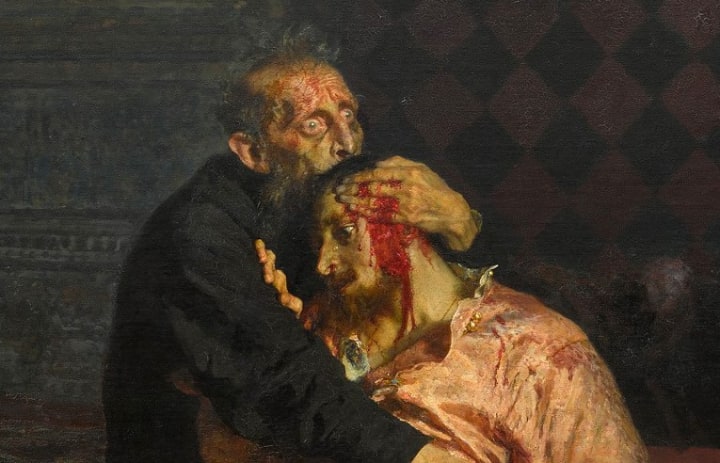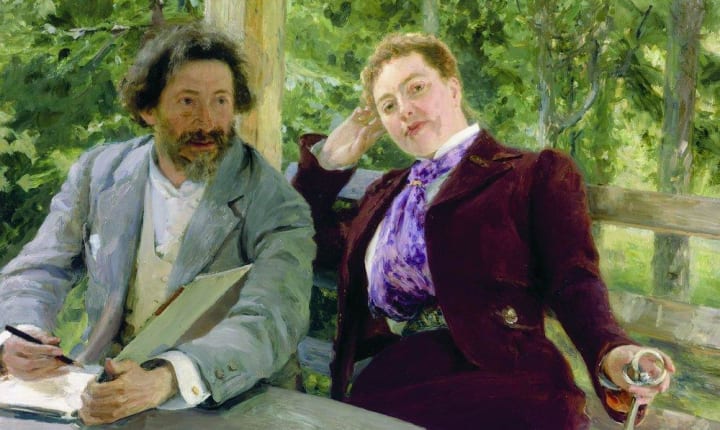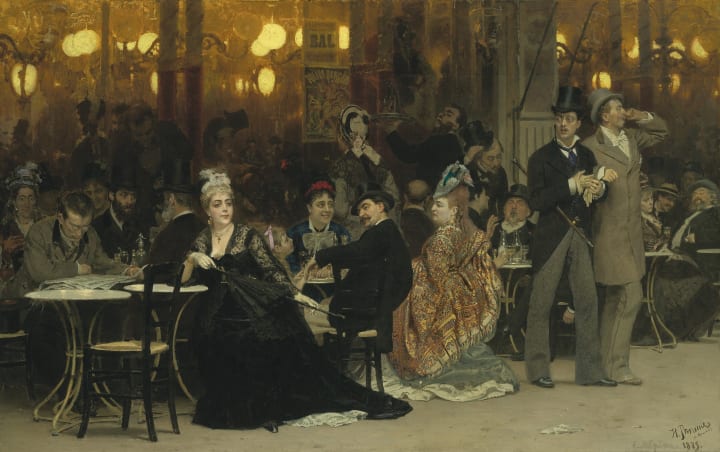A Terrible Truth and its Consequences
A small, quick peek into Art History, Part 3

He killed his son. And unfortunately, for him, he might have regretted it as soon as it was done. Rage is an interesting trait in humans because it is one of the only traits that shows our true animalistic nature. We are nature. We are part of this cycle. In our minds and bodies, we hold the truth--our undeniable power to be gods of life and death.
But it is after the rage that is even more interesting. It is the tears, the pain, the regret, and grief. It is the reminder of our evolution and the complexities of our emotions.
The image is of an oil painting by Ilya Repin called "Ivan the Terrible and his Son," finished in 1885. It depicts Ivan IV, known as Ivan the Terrible, the first Tsar of Russia, and his eldest son and heir, Ivan Ivanovich, murdered in a fit of rage.
Why did he murder his heir? Well, there is much speculation, and I believe no one knows the true details of the argument that was had right before the scepter blow to the head. Whether it was the Tsar causing a miscarriage of his son's wife or a heated discussion about politics, or just personal, a clash between father and son, it's still quite a horrific, final moment between the two.
And what happened after? Ivan the Terrible reportedly fell into a deep depression and withdrew from public life for several months. He also expressed remorse and sorrow for his actions in letters to influential individuals, including the Metropolitan of Moscow, where he expressed the loss of his heir and asked for forgiveness. Though was it true grief or a mask to show that he was not as heartless and insane as the public could have seen him? One would have to ask him. In his later years, Ivan suffered from debilitating health issues, including severe pain and mental instability, which may have contributed to his erratic behavior and violent outbursts.

When looking at the painting, what is the first thing you notice? The blood, a red that is able to overpower almost all the other colors of the image? A symbol of a dark human truth. Or is it the eyes? Wide, unblinking, holding shock, horror, grief, and disbelief. Eyes that must hold steady and still our own. But maybe after or before you noticed the son's hand, still light and pink, illuminated, almost gripping his father's arm.
Then there is the carpet, stained with blood. The chair knocked over. The discarded scepter. The room, dimly lit, but if shown in the bask of sunlight, would reveal the power and royalty that occupied it.
Ilya Repin, a realist painter, uses light, color, and subject to make us see what he wants us to see.

As you may have guessed, the painting remains controversial, even in the present day. It is said that Repin created this work not to make a political statement about the first Tsar of Russia himself or Russian politics as a whole, but rather as a metaphor for the assassination of Tsar Alexander II by a bomb and the subsequent executions of the assassins by hanging. However, this interpretation was not universally accepted, particularly among Russian nationalists who saw it as an attack on Russian power then and possibly even now. In 2018, an incident occurred in which a man took a metal pole to the painting during an exhibition.
No matter the controversy, the painting is still a perfect example of a skillful artist who uses realism not as a copy image, but as symbolism and clear expression of his time.

Rage and blood go hand in hand. It is human. Too human. Perhaps, in the distant future, this combination will only be depicted through words and colors. But for now, we have it all. For now, we have paintings like 'Ivan the Terrible and His Son' to remind us, always reminding us of the possibilities of our nature. And artists like Ilya Repin, who are not afraid to show us that truth.

About the Creator
K. Kocheryan
I write, delete, write, and on most days, delete again.
Reader insights
Outstanding
Excellent work. Looking forward to reading more!
Top insights
Easy to read and follow
Well-structured & engaging content
Compelling and original writing
Creative use of language & vocab
Expert insights and opinions
Arguments were carefully researched and presented
On-point and relevant
Writing reflected the title & theme
Excellent storytelling
Original narrative & well developed characters
Heartfelt and relatable
The story invoked strong personal emotions
Masterful proofreading
Zero grammar & spelling mistakes
Eye opening
Niche topic & fresh perspectives







Comments (24)
A well deserved top story, and a very accurate description of these art works.
Congratulations 🎉🎉 for top story 🥳. "Your work never fails to leave me speechless. You have a rare talent that deserves all the recognition it receives."
Congrats on Top Story!
This eerie depiction of human nature and its effects is made even more understandable by your perceptive analysis of the picture and its historical background.
Written well and true narrative with fantastic characters https://vocal.media/fiction/echoes-of-loyalty
Excellent! I knew nothing about this story or painting, and now I am very curious...
This is fantastic. I really enjoy reading about the history behind such a piece of art. The painting is fascinating, but what is going on in the painting--even more so! Nice work on the historical background!
The look in those widely opened eyes expresses shock at the realisation of the action and perhaps sorrow.
Very sad..i cannot find words to say more but all I can say is very well written
Those eyes! Extraordinary!
Congrats on the top story. I remember seeing Repin's work when I visited the Tretyakov Gallery in Moscow - powerful stuff. Would be interested in your thoughts on Levitan; I really love his landscapes and have happy memories of trips to Plyos.
heart touching,sad and painful
Definitely noticed the eyes first, wide and disbelieving, in state of disassociation or denial. I say it at every opportunity that rises that there are dark elements within human nature that most believe have been removed through cultivation and assimilation. We cannot escape our origins. It's in our very genes to be as violent as any other predator. But we have the unique ability to recognize those innate aspects and decide to act on them or not. I appreciate art like this, holding up a mirror so we can reflect on who we chose to become. And you did an amazing job with this article, leaving a powerful message here.
Damn those eyes! They make me feel his remorse.
That's a helluva portrait. Whoever painted it has exceptional skills indeed.
I haven’t seen this painting of Ivan the Terrible before - but the eyes speak volumes. Great piece of writing too. Nice.
Very well done.
I vividly remember the first time I saw a picture of this painting. I think this painting singlehandedly started my obsession with expressive eyes in my own writing and art. The expression in not just Ivan the Terrible's eyes but his son's is beyond words. You did a great job discussing it. An absolute and haunting masterpiece!
It's Repin's most mesmerizing work, and I've been fascinated by it since my childhood. No matter which version, Ivan's son was dead, and that disrupted the dynasty. Absence of the heir led into the dark years of the Time of Troubles after Ivan The Terrible's death.
It is in the eyes, isn't it, that the pain can be beheld? I think that they say so much. To do that, Repin must be a skilled artist indeed as well as an astute reader of human nature.
I make about $8,000-$12,000 a month online. It’s enough to comfortably replace my old job income, especially considering I only work about 10-13 hours a week from home. I was amazed at how easy it was after I tried it copy below web........... COPY HERE---------->> Www.Smartwork1.com
Fascinating piece of art and history! And very well written exposition!
I always have been fascinated by the painting in a horror study. Truly arresting as another comment says, and I agree. Those eyes. Wow ❗
An arresting painting, which you analyzed in an enlightening way. Nicely done!